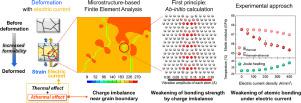Applied Materials Today ( IF 7.2 ) Pub Date : 2020-11-06 , DOI: 10.1016/j.apmt.2020.100874 Moon-Jo Kim , Sangmoon Yoon , Siwook Park , Hye-Jin Jeong , Ju-Won Park , Kuntae Kim , Janghyun Jo , Taehoon Heo , Sung-Tae Hong , Seung Hyun Cho , Young-Kyun Kwon , In-Suk Choi , Miyoung Kim , Heung Nam Han

|
Electroplastic phenomenon has been demonstrated by that the elongation increases remarkably during deformation under electric current without a significant elevation of temperature due to Joule heating. Since the 1960s, the electroplasticity has been actively investigated; however, an exact explanation of the mechanism has been lacking. In this study, the origin of electroplasticity in metallic materials is elucidated based on first principle calculation, finite element simulation and experimental approaches. First principle calculations on a system that includes a grain boundary, which is the general defect in polycrystalline metallic materials, show that a charge imbalance near defects weakens drastically atomic bonding under electric current. The electroplastic behavior could be well reproduced with a small-scale, microstructure-based finite element simulation, which incorporates an effective temperature near defects under electric current. The effective temperature under electric current reflects the weakening of atomic bonding due to charge imbalance. In addition, the weakening of atomic bonding was confirmed by measuring the elastic modulus under electric current, which is inherently related to the atomic bonding strength. It can be said that the mechanical properties under electric current ultimately depend on the existing defects in metallic materials.
中文翻译:

阐明金属材料中电塑性的起源
通过在电流下变形期间伸长率显着增加而没有因焦耳加热引起的温度显着升高,证明了塑性现象。自1960年代以来,一直积极研究电塑性。但是,缺乏对该机制的确切解释。在这项研究中,基于第一性原理计算,有限元模拟和实验方法,阐明了金属材料中电塑性的起源。在包含晶界的系统上进行的第一原理计算是多晶金属材料中的常见缺陷,显示出缺陷附近的电荷不平衡会在电流下极大地削弱原子键合。小规模可以很好地再现其塑性行为,基于微结构的有限元模拟,该模拟结合了电流下缺陷附近的有效温度。电流下的有效温度反映了由于电荷不平衡导致原子键的减弱。另外,通过测量电流下的弹性模量证实了原子键的弱化,这与原子键强度有内在联系。可以说,电流下的机械性能最终取决于金属材料中存在的缺陷。通过测量电流下的弹性模量可以证实原子键合的弱化,这与原子键合强度有着内在的联系。可以说,电流下的机械性能最终取决于金属材料中存在的缺陷。通过测量电流下的弹性模量可以证实原子键合的弱化,这与原子键合强度有着内在的联系。可以说,电流下的机械性能最终取决于金属材料中存在的缺陷。









































 京公网安备 11010802027423号
京公网安备 11010802027423号